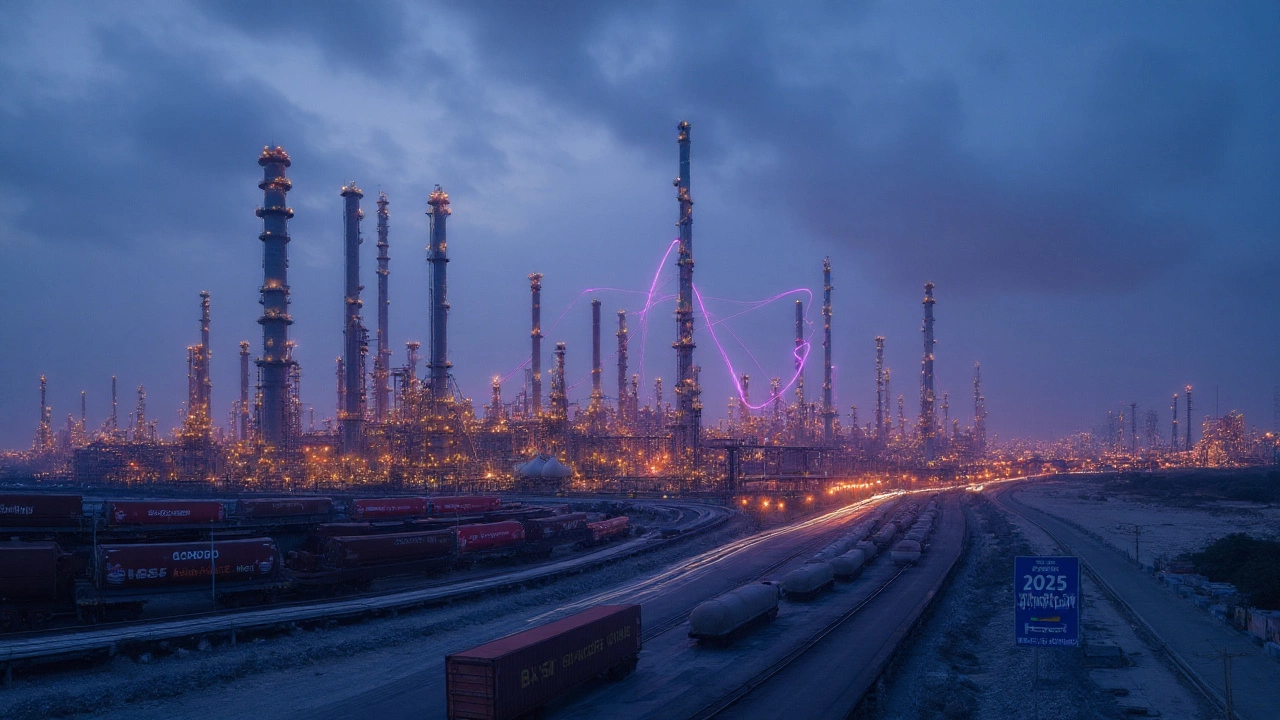Top 5 Chemical Manufacturing Companies in 2025: Leaders, Revenues, and What They Make

You’re here for a clean answer to a messy question: which chemical manufacturing companies are on top right now? The catch: rankings shift with oil prices, currency swings, and how each source defines “chemical sales.” So here’s the practical approach-give you a defendable top five based on 2023/2024 reported results and respected industry rankings, plus the “how” behind the list so you can stress-test it for your needs (sourcing, partnerships, investing, careers).
- The steady top tier for 2025: BASF, Dow, SABIC, Sinopec (chemicals segment), and Ineos.
- These five appear consistently in ICIS Top 100 and C&EN Global Top 50 lists and in company 2024 reports.
- “Top” depends on chemical sales (not total energy), scope (commodity vs. specialty), and geographic spread.
- If you need specialty-only or gases, expand your view (Shin-Etsu, Linde, Air Liquide, Evonik, Arkema).
- Use the comparison checklist below to match the right supplier to your volumes, specs, and risk tolerance.
The top five in 2025: who they are, what they make, and why they lead
Quick note on method: I’m using the latest full-year company disclosures (2023 reported in 2024/2025), plus cross-checks with ICIS Top 100 Chemical Companies (2024) and C&EN Global Top 50 (2024). The list is not strictly ranked because different sources treat integrated energy firms differently. But these five show up at the top across sources.
BASF (Germany)
Why it’s here: BASF is the archetype of a diversified chemical major-petrochemicals, intermediates, performance materials, coatings, battery materials, crop solutions. Its Verbund sites (Ludwigshafen; Antwerp; new Zhanjiang complex ramping) give it strong cost and logistics integration.
Scale and spread: 2023 sales landed in the €60-70bn range, with global production footprints across Europe, Asia, and the Americas. BASF’s portfolio balance helps it ride commodity cycles better than pure ethylene-to-polymer players.
What they’re known for: MDI/TDI (polyurethanes), engineering plastics, auto coatings, catalysts, and ag solutions. BASF is also pushing battery materials in Europe and Asia as EV demand matures.
Sustainability moves: Net-zero by 2050 target; early-phase carbon capture and electrified steam cracker pilots, with published Scope 1-3 disclosures in its 2024 Integrated Report.
Good fit for: OEMs and tier suppliers wanting global specs with tight technical service (auto, consumer, construction, agriculture). Less ideal if you want a niche, low-volume specialty with boutique formulation-though BASF has pockets of that, too.
Dow (United States)
Why it’s here: A pure-play chemical company after the DowDuPont separation, Dow is heavy in polyethylene, elastomers, silicones (via Dow Consumer Solutions), and packaging resins-core inputs for consumer goods, auto, building, and healthcare.
Scale and spread: 2023 net sales in the mid-$40 billions. A strong footprint in the U.S. Gulf Coast and Latin America, with advantaged ethane feedstock improving cost competitiveness.
What they’re known for: Packaging and specialty plastics, industrial intermediates, and silicones. Dow’s application development centers are a draw for converters needing throughput and film performance.
Sustainability moves: 2050 net-zero plan, multiple mechanical/advanced recycling partnerships, and announced projects for electrified crackers and lower-carbon steam.
Good fit for: High-volume packaging and mobility customers that need consistency, scale, and supply resilience. If your spec demands ultra-niche chemistry, you might find better fits among specialty-only peers.
SABIC (Saudi Arabia)
Why it’s here: Majority-owned by Saudi Aramco, SABIC is a leading petrochemicals and specialty player with deep integration to advantaged feedstock. Its product slate spans methanol, fertilizers (via affiliates), polymers, and engineering thermoplastics.
Scale and spread: 2023 revenue in the high $30 billions, with joint ventures (e.g., with ExxonMobil on U.S. Gulf Coast) extending reach beyond the Middle East. Asia remains a core demand center.
What they’re known for: Polyethylene, polypropylene, polycarbonate, and specialty polymers for automotive, healthcare, and consumer applications. SABIC also invests in circular polymers and CO2-to-chemicals pilots.
Sustainability moves: Carbon intensity reductions published in the 2024 annual report, circular economy programs (TRUCIRCLE), and several advanced recycling collaborations.
Good fit for: Converters and OEMs looking for competitive cost positions in commodity polymers and access to specialty engineering materials from one umbrella supplier.
Sinopec - Chemicals Segment (China)
Why it’s here: On chemical sales alone, Sinopec’s chemicals arm ranks among the world’s largest. The company’s massive integrated refinery-chemical sites supply ethylene chains, aromatics, and polymer resins across China, the world’s biggest demand pool.
Scale and spread: Chemical segment sales typically sit in the ~$60-70bn range (depending on prices and FX). Sinopec’s advantage is scale and domestic demand proximity, which matters when supply chains are tight.
What they’re known for: Ethylene, propylene, aromatics (BTX), polyethylene, polypropylene, and synthetic rubbers. The company continues to expand into higher-value derivatives and specialty intermediates.
Sustainability moves: Emissions targets aligned to China’s 2060 neutrality goal, with renewables integration and efficiency upgrades reported in recent sustainability disclosures.
Good fit for: Asia-based buyers needing reliable commodity resin supply close to end markets. If you’re sourcing specialty, high-spec formulations for regulated industries, you’ll likely compare Sinopec with global specialty peers.
Ineos (United Kingdom)
Why it’s here: Privately held and highly acquisitive, Ineos is a heavyweight in olefins, polyolefins, vinyls (through Ineos Inovyn), solvents, phenols, and acrylonitrile. It has grown by buying under-invested assets and lifting them with disciplined operations.
Scale and spread: Estimated 2023 turnover in the $50-60bn range across multiple divisions. Extensive footprint in Europe and North America, and a growing profile in Asia.
What they’re known for: Ethylene and propylene chains, PVC via Inovyn, nitriles, and phenol-core building blocks for coatings, textiles, appliances, and autos.
Sustainability moves: Hydrogen pilots, waste-to-methanol, and circular polyolefins undertakings. Regional disclosures vary, as is common with private ownership.
Good fit for: Buyers who want tough-to-beat commodity pricing and dependable backbone chemicals. Less ideal if you need deep formulation support outside the major commodity and intermediate families.
Why not list others? LG Chem, LyondellBasell, Mitsubishi Chemical Group, Formosa Plastics, Shin-Etsu Chemical, Reliance (chemicals segment), Covestro, Arkema, and Evonik are right behind and often break into the top five depending on the metric (pure chemical sales vs. consolidated revenue, currencies, and scope definitions). If your use case leans specialty, gases, or electronics materials, those may be a better fit than a commodity-heavy major.
| Company | HQ | 2023 Chemical Sales (approx.) | Core Strengths | Key End Markets | Climate Targets |
|---|---|---|---|---|---|
| BASF | Germany | €60-70bn | Diversified portfolio, Verbund integration, coatings, PU | Auto, construction, consumer, ag | Net-zero 2050 (Scope 1-2 focus, Scope 3 transparency improving) |
| Dow | United States | $40-50bn | PE, elastomers, silicones; strong application support | Packaging, mobility, industrial | Net-zero 2050; recycling and electrified cracker pilots |
| SABIC | Saudi Arabia | $35-45bn | Polyolefins, engineering thermoplastics, advantaged feedstock | Consumer, healthcare, auto | Intensity reductions; circular polymers (TRUCIRCLE) |
| Sinopec (Chemicals) | China | $60-70bn | Ethylene chain, aromatics, large integrated complexes | Packaging, textiles, appliances | Aligned with China 2060 neutrality; efficiency upgrades |
| Ineos | United Kingdom | $50-60bn | Olefins, polyolefins, vinyls, phenol, nitriles | Coatings, textiles, auto, consumer | Hydrogen pilots; circular polymers; regional targets |
Sources: Company 2024 annual and sustainability reports; ICIS Top 100 Chemical Companies (2024) by sales; C&EN Global Top 50 (2024). Figures are rounded ranges to reflect price/FX swings and methodology differences.

How to compare them: a simple playbook, examples, and a buyer’s checklist
If you’re picking a supplier or partner, don’t start with brand names. Start with fit. Here’s a quick step-by-step that works for sourcing teams, founders, and even job seekers who want to anchor on resilient product lines.
- Define your chemistry scope: Do you need commodity resins (PE, PP), intermediates (EO, PO, acrylates), or specialty polymers/coatings? Write down CAS numbers and grade specs if you have them.
- Map your geography: Where are your plants, and what are your customs/tariff constraints? A nearby cracker beats a famous brand if it guarantees lead times.
- Set volume bands: Annual tons, order frequency, and minimum lot sizes. Big names love volume; small lots may push you to regional distributors or specialty players.
- Rank what you value: price stability, technical service, recycled content, food-contact or pharma-grade compliance, low-carbon footprint, or dual-sourcing resilience.
- Screen for certifications: REACH, TSCA, ISO 9001/14001, FDA/EFSA where relevant. Ask for letters of guarantee and standard data packages (SDS, COA formats).
- Check cycle risk: Commodity-heavy portfolios are cheaper but swing with oil and gas; specialty-heavy portfolios cost more but offer margin stability and deeper support.
- Run a pilot: Validate processability, mechanicals, and aging in your line. Document the exact line settings that worked to speed up repeat orders.
Fast heuristics
- If your BOM is 70% packaging resins, shortlist Dow, SABIC, Sinopec (regional), and LyondellBasell; keep BASF for coatings and additives.
- Need engineering plastics for under-hood auto or medical devices? Look at BASF, SABIC, Covestro, and DSM-Firmenich (for specialty). For silicones, Dow has the edge.
- Chasing the lowest delivered cost in Europe? Put Ineos, BASF, and Ineos Inovyn on the call sheet; match feedstock advantages to your location.
- Want recycled content claims? Ask for mass-balance certifications and product passports; don’t accept generic “recycled” labels without chain-of-custody proof.
Three quick scenarios
- Packaging converter in Texas: You care about film optics and seal strength. Start with Dow’s application team for PE blends; cross-quote SABIC’s U.S. JV resins; keep LyondellBasell for supply resilience; run trials on two lines for anti-block and slip.
- Tier-1 auto supplier in Germany: Your focus is heat resistance and paint adhesion. Talk to BASF for engineering plastics and coatings stack; pull a SABIC PC/ABS datasheet for trim parts; compare flammability ratings (UL 94) and fogging results on your exact molds.
- Consumer appliance OEM in India: You want gloss and chemical resistance at scale. Shortlist Ineos (styrenics, ABS via partners), BASF for coatings and performance additives; test regional Sinopec grades for cost wins, then qualify two suppliers to hedge FX moves.
The buyer’s checklist (copy-paste for your RFP)
- Product spec + CAS + grade + required regulatory (REACH/TSCA/FDA/EFSA) + target property window (MFI, tensile, Vicat, haze, etc.).
- Annual volumes + min lot sizes + typical monthly cadence + surge capacity ask.
- Delivery window + INCO terms + safety stock policy + consignment option.
- COA, SDS, and change control process + notification lead times for formulation tweaks.
- Recycled or bio-based content target + mass-balance certification requirement (ISCC PLUS or equivalent).
- Carbon intensity disclosure (kg CO2e/kg product) + data source (plant-level preferred).
- Technical service scope: on-site trials, mold flow support, failure analysis turnaround.
- Price adjusters: formula index (naphtha/ethane), FX bands, and review cadence.

FAQ, next steps, and troubleshooting different situations
FAQ
- Are oil and gas companies counted? Only their chemical segments. That’s why Sinopec shows up. Rankings like C&EN and ICIS break out “chemical sales” to make apples-to-apples comparisons.
- Who’s largest by market cap, not sales? It shifts. Specialty and gases players (e.g., Linde, Air Liquide) can outrank commodity majors on valuation due to stable margins.
- Which is the most “sustainable”? Different strengths. BASF has deep disclosure and pilots; Dow is active on circular plastics; SABIC scales circular polymers; Ineos pushes hydrogen pilots; Sinopec is upgrading efficiency. Ask for product-level CO2e and third-party audits.
- Do I pick one supplier or two? For critical polymers, dual-source if possible-one global major plus one regional alternative. For tight specs (medical, aerospace), you may need single-source with strict change control.
- Will the top five change in 2025? It can. Demand in China, oil/naphtha spreads, and FX can shuffle ranks. Expect the same names to dominate the top tier, with LG Chem, LyondellBasell, and Shin-Etsu pressing in.
What if your need is specialty-only?
Look at Shin-Etsu (PVC and silicones), Evonik (additives, amino acids), Arkema (fluorinated materials, adhesives), Covestro (polycarbonates, coatings), and DuPont (electronics, industrial solutions). For industrial gases essential to many chem processes and fabs, Linde and Air Liquide are leaders.
Next steps by persona
- Procurement manager at a converter: Shortlist two majors plus one regional supplier. Run 30-day plant trials, collect COAs and CO2e per kg, and score on total delivered cost and line uptime.
- Manufacturing founder: Start via distributors for smaller lots to avoid MOQs. Once volumes hit predictable bands, negotiate direct contracts with a major for price stability.
- Job seeker (engineer or chemist): Target divisions with margin stability-coatings, silicones, engineering plastics, or catalysts. Read the latest 10-K/annual report “Outlook” section and the sustainability report to see where capex is headed.
- Investor/analyst: Track operating rates, cracker feedstock spreads (ethane vs. naphtha), and China demand recovery. Specialty exposure and application development centers are signals of margin resilience.
Troubleshooting
- If rankings don’t match across sources: Check if the source used total company revenue or pure chemical sales. Integrated energy firms skew totals.
- If your region has import constraints: Prioritize local plants or JVs; ask for regional grade equivalents. Lead time beats headline price in most real-world schedules.
- If commodity prices whipsaw: Use index-linked pricing with floors/ceilings and keep buffer inventory at critical nodes.
- If you need compliance for food/pharma: Demand migration testing, extractables/leachables data, and change control agreements in writing.
- If you’re chasing recycled content claims: Verify with chain-of-custody (e.g., ISCC PLUS) and product passports; audit the mass-balance methodology.
Credibility note: This shortlist and guidance are grounded in 2024/2025 company filings (BASF Report 2024; Dow 2024 Form 10-K; SABIC 2024 Annual Report; Sinopec 2024 reports), and cross-checked with ICIS Top 100 and C&EN Global Top 50 (2024). Method choices matter-use the checklist to tailor the “top five” to your exact product and region.